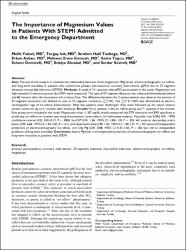| dc.contributor.author | Yüksel, Melih | |
| dc.contributor.author | Işık, Turgay | |
| dc.contributor.author | Tanboğa, İbrahim Halil | |
| dc.contributor.author | Ayhan, Erkan | |
| dc.contributor.author | Erimşah, Mehmet Emre | |
| dc.contributor.author | Topçu, Selim | |
| dc.contributor.author | Demirelli, Selami | |
| dc.contributor.author | Aksakal, Enbiya | |
| dc.date.accessioned | 2019-09-25T11:17:03Z | |
| dc.date.available | 2019-09-25T11:17:03Z | |
| dc.date.issued | 2017 | en_US |
| dc.identifier.issn | 1076-0296 | |
| dc.identifier.issn | 1938-2723 | |
| dc.identifier.uri | https://doi.org/10.1177/1076029616658119 | |
| dc.identifier.uri | https://hdl.handle.net/20.500.12462/6472 | |
| dc.description | Yüksel, Melih (Balikesir Author) | en_US |
| dc.description.abstract | Aim: The aim of this study is to examine the relationship between initial magnesium (Mg) levels, electrocardiographic no-reflow, and long-term mortality in patients who underwent primary percutaneous coronary intervention (pPCI) due to ST-segment elevation myocardial infarction (STEMI). Methods: A total of 111 patients with pPCI participated in the study. Magnesium and high-sensitive C-reactive protein (hs-CRP) were measured. The sum of ST-segment elevation was measured immediately before and 60 minutes after the restoration of coronary flow. The difference between the 2 measurements was taken as the amount of ST-segment resolution and defined as sum of ST-segment resolution (Sigma STR). The Sigma STR <50% was determined as electrocardiographic sign of no-reflow phenomenon. After the patients were discharged, they were followed up for major adverse cardiac events for up to 51 months after discharge. Results: Forty patients in the no-reflow group and 71 patients in the normal-flow group were included in the study. Magnesium value <= 1.87 mg/dL initially measured had 77% sensitivity and 59% specificity in predicting no-reflow on receiver operating characteristic curve analysis. In multivariate analyses, Mg (odds ratio [OR]: 0.01, <95% confidence interval [CI]: 0.01-0.12; P = .004), hs-CRP (OR: 1.06, <95% CI: 1.00-1.14; P = .05), left anterior descending artery lesion (OR: 6.66, <95% CI: 1.45-3.05; P = .01), and reperfusion time (OR: 1.01, <95% CI: 1.00-1.01; P = .03) were still independent predictors of electrocardiographic no-reflow, and only Mg (OR: 0.08, <95% CI: 0.01-1.03; P = .05) was still an independent predictor of long-term mortality. Conclusion: Serum Mg level is an independent predictor of electrocardiographic no-reflow and long-term mortality in patients with STEMI. | en_US |
| dc.language.iso | eng | en_US |
| dc.publisher | Sage Publications Inc | en_US |
| dc.relation.isversionof | 10.1177/1076029616658119 | en_US |
| dc.rights | info:eu-repo/semantics/openAccess | en_US |
| dc.subject | Primary Percutaneous Coronary Intervention | en_US |
| dc.subject | ST-Segment Elevation Myocardial Infarction | en_US |
| dc.subject | Electrocardiographic No-Reflow | en_US |
| dc.subject | Magnesium | en_US |
| dc.title | The importance of magnesium values in patients with stemi admitted to the emergency department | en_US |
| dc.type | article | en_US |
| dc.relation.journal | Clinical and Applied Thrombosis-Hemostasis | en_US |
| dc.contributor.department | Tıp Fakültesi | en_US |
| dc.identifier.volume | 23 | en_US |
| dc.identifier.issue | 4 | en_US |
| dc.identifier.startpage | 329 | en_US |
| dc.identifier.endpage | 335 | en_US |
| dc.relation.publicationcategory | Makale - Uluslararası Hakemli Dergi - Kurum Öğretim Elemanı | en_US |


















